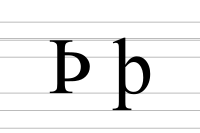Thorn (letter) facts for kids
Quick facts for kids Þ |
|
|---|---|
| Þ þ | |
 |
|
| Usage | |
| Writing system | Adapted from Futhark and Futhorc into Latin script |
| Type | Alphabetic and logographic |
| Language of origin | Old English language Old Norse language |
| Phonetic usage | [θ] [ð] [θ̠] [z] /θɔːrn/ |
| Unicode value | U+00DE, U+00FE |
| History | |
| Development |
ᚦ
|
| Time period | ~800 to present |
| Descendants | ꝥ, þͤ, þͭ, þͧ, yᷤ, yͤ, yͭ, (possibly) 𐌸 |
| Sisters | None |
| Transliteration equivalents | Θ, th |
| Other | |
| Other letters commonly used with | th, dh |
Thorn (Þ, þ) is a special letter. It was once used in old languages like Old English and Old Norse. Today, it is only used in the modern Icelandic alphabet.
This letter came from an old writing system called the runes. The rune it came from looked like ᚦ. In Anglo-Saxon times, it was called thorn. In Scandinavia, it was called thorn or thurs.
Thorn sounds like the "th" in the English word thick or the "th" in the. In modern Icelandic, it sounds a bit like the "th" in thick. Sometimes, it can sound like the "th" in the, but this is usually written with a different letter called eth (Ð, ð).
The small letter thorn (þ) is unique because it has parts that go both above and below the main line of text. This is called an ascender and a descender.
Contents
How Thorn Was Used
Thorn in English
Old English Writing
The letter thorn was used very early on to write Old English. Another similar letter, eth (ð), was also used. Unlike eth, thorn stayed in use for a long time during the Middle English period. Both letters were used for the "th" sound. Sometimes, the same writer would use both thorn and eth.
Middle and Early Modern English
Around the 1300s, people started using the two-letter combination th more often. At the same time, the letter thorn started to look less like its original shape. It lost its top part, looking more like the letter P.
By this time, th became the main way to write the "th" sound. Thorn was mostly used for a few common words and shortcuts. When printing presses arrived, they often didn't have the thorn letter. So, printers started using the letter y instead because it looked similar. This is why you might see "ye" in old texts, like "Ye Olde Curiositie Shoppe." But remember, "ye" was never pronounced like the "y" in yes. It was always pronounced like "the." For example, the first printing of the King James Version of the Bible in 1611 used ye for "the."
Old Abbreviations
Here are some shortcuts (called scribal abbreviations) that used the letter thorn in Middle and Early Modern English:
 (þͤ) – This was a Middle English shortcut for the word the.
(þͤ) – This was a Middle English shortcut for the word the. (þͭ) – This was a Middle English shortcut for the word that.
(þͭ) – This was a Middle English shortcut for the word that. (þͧ) – This was a rare Middle English shortcut for the word thou (which means "you").
(þͧ) – This was a rare Middle English shortcut for the word thou (which means "you").
Later, when printers didn't have the thorn letter, they used the letter y instead:
- yᷤ – An Early Modern English shortcut for the word this.
 (yͤ) – An Early Modern English shortcut for the word the.
(yͤ) – An Early Modern English shortcut for the word the. (yͭ) – An Early Modern English shortcut for the word that.
(yͭ) – An Early Modern English shortcut for the word that.
Modern English
You can still see thorn, in the form of a "Y," in old-fashioned phrases like "ye olde". People sometimes mistakenly pronounce the "Y" as "yee," but it should always be pronounced like "the."
Thorn in Icelandic
Icelandic is the only language still using the letter thorn today. In Icelandic, it's called þoddn or þorn. It is the 30th letter in the Icelandic alphabet. When Icelandic words are written in English, thorn is usually changed to th. For example, the name of Hafþór Júlíus Björnsson becomes Hafthor.
Thorn's sound in Icelandic hasn't changed much over time. Long ago, before the letter eth (ð) was used, thorn also represented the "th" sound found in words like verða (meaning "to become").
The use of thorn in Icelandic comes from the runic alphabet. A 12th-century text called the First Grammatical Treatise describes it:
| Staf þann er flestir menn kalla þ, þann kalla ég af því heldur þe að þá er það atkvæði hans í hverju máli sem eftir lifir nafnsins er úr er tekinn raddarstafur úr nafni hans, sem alla hefi ég samhljóðendur samda í það mark nú sem ég reit snemma í þeirra umræðu. [...] Höfuðstaf þe-sins rita ég hvergi nema í vers upphafi því að hans atkvæði má eigi æxla þótt hann standi eftir raddarstaf í samstöfun. – First Grammarian, First Grammatical Treatise |
The letter which most people call thorn I will call the. This is so its sound in every word is what's left when the vowel is taken out of its name. I've done this for all consonants, as I wrote earlier. [...] I only use the capital the at the start of a section, because its sound can't be stretched out, even if it comes after a vowel in a syllable. – First Grammarian, First Grammatical Treatise, translated by Einar Haugen |
Computing Codes
Computers use special codes to show letters like thorn. Here are some common codes for Þ and þ:
| Letter | Þ | þ |
| Unicode Name | LATIN CAPITAL LETTER THORN | LATIN SMALL LETTER THORN |
| Unicode Code | 00DE | 00FE |
| Character entity reference | Þ | þ |
| Windows-1252, ISO-8859-1, ISO-8859-15 |
DE | FE |
| LaTeX | \TH | \th |
Different Forms of Thorn
In medieval times, writers used different forms of thorn for shortcuts:
- Error using : Input "A764" is not a hexadecimal value.
- Error using : Input "A765" is not a hexadecimal value.
- Error using : Input "A766" is not a hexadecimal value.
- Error using : Input "A767" is not a hexadecimal value.
- Error using : Input "A7D3" is not a hexadecimal value. was used in a Middle English book called the Ormulum.
See Also
- Pronunciation of English ⟨th⟩ – How the "th" sound is made in English.
- Sho (letter) (Ϸ) – A similar-looking letter from the Greek alphabet.
- Yogh (Ȝ) – Another letter used in Middle English and Older Scots.
- Wynn (Ƿ) – Another runic letter used in Old English.
- Eth (Ð) – Another letter used in Old English and Icelandic.





